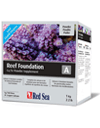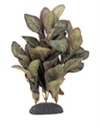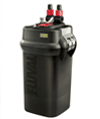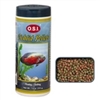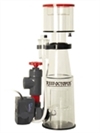What is Cyanobacteria?
Cyanobacteria is a slimy algae-like bacteria that can grow in both freshwater and saltwater aquariums. Cyanobacteria can be blue, green, or red, and it looks like slimy sheets that cover the surfaces of the aquarium glass, substrate, rocks, plants, and corals. Sometimes bubbles will build up in the slimy sheets. The slime generally wipes away very easily. However, it grows back almost overnight. The slime can also disappear at night and then reappear in the morning. For the most part cyanobacteria is a problem because it is ugly. Animals are generally not harmed by cyanobacteria. But if the cyanobacteria build-up is heavy enough it can start to cover plants and corals. Ultimately, this will irritate them and stop them from photosynthesizing—leading to plant and coral death.
What Causes Cyanobacteria?
Cyanobacteria is one of the oldest and most durable organisms on the planet. Some scientists even believe it may have been the first, or one of the very first, lifeforms to evolve. It can survive in extreme conditions that other animals cannot live in, and it is present in small amounts all over the planet. Even if you don’t see cyanobacteria there is still a small amount in your aquarium. The problem is when the small amount of cyanobacteria becomes a large amount of cyanobacteria. Below is a list of conditions that tend to lead to a cyanobacteria bloom.
- Extra Low Nutrients (Especially Nitrate)
- Low Water Movement
- Low Microbial Diversity
How to Prevent Cyanobacteria
Unlike algae, where purchasing snails or algae eating fish can keep the algae at bay, there are no animals that reliably eat cyanobacteria. The main things that keeps cyanobacteria in check in nature are unfavorable environmental conditions and competition with other organisms. These are the things we need to change to prevent cyanobacteria.
Increasing Nutrients
To prevent cyanobacteria and keep it from coming back the best approach is to change the conditions in the aquarium so they are not favorable to cyanobacteria. Cyanobacteria have the ability of nitrogen fixation. This means that cyanobacteria do not need any nitrate in the water to grow. It can get the needed nitrogen from the nitrogen gas in the atmosphere. With most algae, if you focus on lowering nitrate levels this will starve out the algae. This is not the case with cyanobacteria. It will use nitrogen from the air to grow. Additionally, if your nitrate is very low then this will stop the algae and plants that compete with cyanobacteria from growing and the cyanobacteria population can explode.
While we focus a lot on keeping aquariums clean and lowering nitrates, some modern filtration technology has gotten so good that we can easily send the nitrate level to absolute zero. We want low nitrate levels but not absolute zero. We recommend nitrates below 20 and not zero. If you have a cyanobacteria problem test your nitrate levels and make sure that they are not zero. If they are too low, you can increase feeding, reduce your filtration, or add nitrate to let a little bit of nitrate build-up. Increasing feeding is pretty straightforward, but decreasing filtration is a bit less intuitive. Decreasing filtration could look like using less chemical filtration media, reducing the photoperiod of your refugium or algae scrubbers’ lights, turning off your protein skimmer part of the day, or using coarser filter media that lets more debris pass through. Adding nitrate to the water is most common in planted tanks. If you have a planted aquarium then all of the plants are sucking nitrogen out of the water in order to grow. If you have no nitrate in your water then the plants are starving. You can add nitrate back by using a nitrogen fertilizer such as
Flourish Nitrogen. This will make the environment more hospitable for plants and less hospitable for cyanobacteria.
Increasing Water Movement
Cyanobacteria tends to accumulate in low-flow areas of the tank. This is for two reasons. Cyanobacteria does not have a hold-fast like algae does. The hold-fast is what allows algae to grip to the algae or glass. The lack of a holdfast is what makes it so easy to wipe away cyanobacteria. Additionally, low flow areas tend to accumulate detritus. This detritus acts like a compost heap that fertilizes cyanobacteria and can help it to grow. Start by siphoning out all the pockets of detritus from your aquarium and consider adding circulation pumps to increase the water movement. Increasing water movement alone will not usually get rid of cyanobacteria, but it makes it more difficult for the cyanobacteria to regrow.
Increase Microbial Diversity
Some of the chief competitors with cyanobacteria are other bacteria. Lucky for us there are many other forms of bacteria that use the same resources and compete for the same ecological niche as cyanobacteria but they aren’t ugly and invasive like cyanobacteria can be. In new aquariums in particular there is not much bacteria yet living in the aquarium and because cyanobacteria is so common it can be the first bacteria to start growing. Adding some beneficial and desirable bacteria can help to out-compete cyanobacteria. Our favorite bottled bacteria is
Brightwell Microbacter7. Microbacter 7 works in both freshwater or saltwater and it contains seven strains of beneficial bacteria that can compete with cyanobacteria and stop it from getting out of control.
Stopping a Cyanobacteria Invasion
Cyanobacteria prevention techniques can stop Cyanobacteria from becoming a problem and they can even fix small problems, but what if your tank is smothered in an army of cyanobacteria invaders? If you have a very bad problem we have a 3-step process to fixing severe cyanobacteria problems.
Step 1: Manually Remove As Much Cyanobacteria As You CanStart by performing a water change and using a siphon hose to suck out as much of the cyanobacteria as you can. If you wind up sucking out some of the sand then just remember that sand is cheap. Do your best to get all of the cyanobacteria off all of the corals, plants, glass, rocks, decorations, and substrate. You might be thinking, “
I have tried that before but it just grows back the next day”. This is why there are steps 2 and 3.
Step 2: Use a Cyanobacteria Remover
Once most of the cyanobacteria have been removed, you will want to use a cyanobacteria remover product. There are multiple different manufacturers of cyanobacteria remover products. UltraLife has
Red Slime Stain Remover and
Blue-Green Slime Remover, Boyd’s has
ChemiClean, and Bluelife has
RedCyano RX.
All of these products are essentially mild antibiotics that will kill the cyanobacteria but will inevitably also kill some beneficial bacteria in the aquarium. Because of this we only recommend using one of these cyanobacteria removers if your problem is very bad. To use the product, start by removing all chemical filtration, and turning off UV sterilizers, protein skimmers, and ozone generators. Then add the manufacturer's recommended amount of the product and leave it in the aquarium for two days. After two days do a partial water change and resume your normal filtration.
Step 3: Add Beneficial Bacteria BackAt this point, your tank should look free of cyanobacteria but there is certainly a small amount of cyanobacteria lurking deep in the rockwork and substrate of your aquarium. We want to make sure that it does not come back. Since the beneficial bacteria have also been beaten back by the treatment, you'll want to add them back in to give them a leg up on the cyanobacteria. You'll want the beneficial bacteria to win the recolonization battle. To do this, add a bottled bacteria product such as
Microbacter7. We recommend purchasing a bottle and adding the manufacturer's recommended daily dose until the bottle is gone. After this keep practicing the cyanobacteria prevention techniques to keep the cyanobacteria from coming back.







